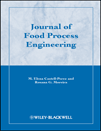SOLID LOSS DURING WATER ABSORPTION OF CHICKPEA (CICER ARIETINUM L.)
Abstract
ABSTRACT
Soluble solid leached out during soaking and cooking of food legumes generally decreases the overall quality of the final products. Solid loss behavior of whole chickpea during soaking and cooking in water was investigated at 20, 30, 50, 70, 85 and 100C. The amount of solid loss and its rate increased with increasing temperature, and the former was 2.3% at 20C and 10.2% at 100C at the end of the process. Carbohydrates and proteins composed of 80–91% of the solid lost. A zeroth-order kinetic model fit the solid loss data. The solid loss rate constant (kds) increased with temperature, and it was 4.7 × 10−5/s at 20C and 240.3 × 10−5/s at 100C. Effect of temperature on kds was determined using an Arrhenius-type equation. The Arrhenius plot exhibited two linear lines crossing at the gelatinization temperature (61C) of the whole chickpea. The activation energy was determined to be 59.5 and 22.6 kJ/g/mol above and below the gelatinization temperature, respectively.
PRACTICAL APPLICATIONS
Soaking and cooking are the two main steps during processing of chickpea. Soluble solid loss into the soaking or cooking water generally decreases the nutritional and economic value of the final product and it is one of the quality indicators of the dry, soaked and soaked/cooked legumes. In the current study, soluble solid loss from whole chickpea seeds during soaking and cooking in water were studied as a function of time and temperature. Results from the current study can be useful in designing the process parameters of soaking and cooking and for the evaluation of the quality of dry or processed whole chickpea.




